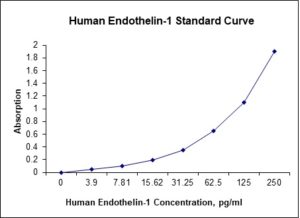Nori Human Endothelin 1 ELISA Kit
$461.00 – $832.00
This ELISA kit is for quantification of ET-1 in human. This is a quick ELISA assay that reduces time to 50% compared to the conventional method, and the entire assay only takes 3 hours. This assay employs the quantitative sandwich enzyme immunoassay technique and uses biotin-streptavidin chemistry to improve the performance of the assays. An antibody specific for ET-1 has been pre-coated onto a microplate. Standards and samples are pipetted into the wells and any ET-1 present is bound by the immobilized antibody. After washing away any unbound substances, a detection antibody specific for ET-1 is added to the wells. Following wash to remove any unbound antibody reagent, a detection reagent is added. After intensive wash a substrate solution is added to the wells and color develops in proportion to the amount of ET-1 bound in the initial step. The color development is stopped, and the intensity of the color is measured.
Alternative names for endothelin 1: Endothelin 1 (ET-1), preproendothelin-1 (PPET1), EDN1
This product is for Laboratory Research Use Only not for diagnostic and therapeutic purposes or any other purposes.
- Description
- How Elisa Works
- Product Citation (0)
- Reviews (0)
Description
Nori Human Endothelin 1 ELISA Kit Summary
Alternative names for endothelin 1: Endothelin 1 (ET-1), preproendothelin-1 (PPET1), EDN1
| Assay Type | Solid Phase Sandwich ELISA |
| Format | 96-well Microplate or 96-Well Strip Microplate |
| Method of Detection | Colorimetric |
| Number of Targets Detected | 1 |
| Target Antigen Accession Number | P05305 |
| Assay Length | 3 hours |
| Quantitative/Semiquantitative | Quantitative |
| Sample Type | Plasma, Serum, Cell Culture, Urine, Cell/Tissue Lysates, Synovial Fluid, BAL, |
| Recommended Sample Dilution (Plasma/Serum) | No dilution for sample <ULOQ; sufficient dilution for samples >ULOQ |
| Sensitivity | 0.8 pg/mL |
| Detection Range | 3.9-250 pg/mL |
| Specificity | Human ET-1 |
| Cross-Reactivity | < 0.5% cross-reactivity observed with available related molecules, < 50% cross-species reactivity observed with species tested. |
| Interference | No significant interference observed with available related molecules |
| Storage/Stability | 4 ºC for up to 6 months |
| Usage | For Laboratory Research Use Only. Not for diagnostic or therapeutic use. |
| Additional Notes | The kit allows for use in multiple experiments. |
Standard Curve
Kit Components
1. Pre-coated 96-well Microplate
2. Biotinylated Detection Antibody
3. Streptavidin-HRP Conjugate
4. Lyophilized Standards
5. TMB One-Step Substrate
6. Stop Solution
7. 20 x PBS
8. Assay Buffer
Other Materials Required but not Provided:
1. Microplate Reader capable of measuring absorption at 450 nm
2. Log-log graph paper or computer and software for ELISA data analysis
3. Precision pipettes (1-1000 µl)
4. Multi-channel pipettes (300 µl)
5. Distilled or deionized water
Protocol Outline
1. Prepare all reagents, samples and standards as instructed in the datasheet.
2. Add 100 µl of Standard or samples to each well and incubate 1 h at RT.
3. Add 100 µl of Working Detection Antibody to each well and incubate 1 h at RT.
4. Add 100 µl of Working Streptavidin-HRP to each well and incubate 20 min at RT.
5. Add 100 µl of Substrate to each well and incubate 5-30 min at RT.
6. Add 50 µl of Stop Solution to each well and read at 450 nm immediately.
Background:
Endothelin 1 (ET-1), also known as preproendothelin-1 (PPET1), is a potent vasoconstrictor that is encoded by the EDN1 gene and produced by vascular endothelial cells.[1] Endothelin 1 is one of three isoforms of human endothelin. Preproendothelin is precursor of the peptide ET-1. Endothelial cells convert preproendothelin to proendothelin and subsequently to mature endothelin, which the cells release. It acts through two types of receptors: ETA and ETB. Apart from a vasoconstrictive action, ET-1 causes fibrosis of the vascular cells and stimulates production of reactive oxygen species.[2] It is claimed that ET-1 induces proinflammatory mechanisms, increasing superoxide anion production and cytokine secretion. A recent study has shown that ET-1 is involved in the activation of transcription factors such as NF-κB and expression of proinflammatory cytokines including TNF-α, IL-1, and IL-6. It has been also indicated that during endotoxaemia, the plasma level of ET-1 is increased in various animal species. Some authors indicate a clear correlation between endothelin plasma level and morbidity/mortality rate in septic patients. These pathological effects of ET-1 may be abrogated at least partly by endothelin receptor blockade. ET-1 receptor antagonists may be useful for prevention of various vascular diseases. ET-1 has been implicated as an important factor in the development of vascular dysfunction and cardiovascular disease.[3] The effects of the ET-1 are carefully regulated through inhibition or stimulation of ET-1 release from endothelium. Endothelial dysfunction is one of the earliest landmarks of vascular abnormalities. Altered function of endothelium may result from absolute decrease in bioavailability of NO as well as from relative augment in ET-1 synthesis, release or activity. Imbalance in the production of vasodilator and vasoconstrictor agents may contribute to the onset of hemodynamic disorders.[4] Endothelin-1 receptor antagonists (Bosentan) are used in the treatment of pulmonary hypertension. Inhibition of these receptors prevents pulmonary vasculature constriction and thus decreases pulmonary vascular resistance.
References
- Inoue,A. et al (1989) J. Biol. Chem. 264 (25), 14954-14959
- Kowalczyk A et al. (2015) Arch Immunol Ther Exp (Warsz). 63: 41–52.
- Böhm F et al. (2007) Cardiovascular Research, 76 (1):8–18.
- Marasciulo FL et al (2006) Curr Med Chem. 13(14):1655-65.
Be the first to review “Nori Human Endothelin 1 ELISA Kit”
You must be logged in to post a review.




























Reviews
There are no reviews yet.